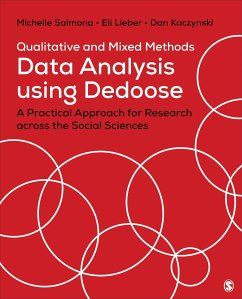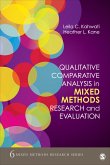Michelle Salmona, Eli Lieber, Dan Kaczynski
Qualitative and Mixed Methods Data Analysis Using Dedoose
A Practical Approach for Research Across the Social Sciences
Michelle Salmona, Eli Lieber, Dan Kaczynski
Qualitative and Mixed Methods Data Analysis Using Dedoose
A Practical Approach for Research Across the Social Sciences
- Broschiertes Buch
- Merkliste
- Auf die Merkliste
- Bewerten Bewerten
- Teilen
- Produkt teilen
- Produkterinnerung
- Produkterinnerung
Qualitative and Mixed Methods Data Analysis Using Dedoose : A Practical Approach for Research Across the Social Sciences provides both new and experienced researchers with a guided introduction to dealing with the methodological complexity of mixed methods and qualitative inquiry using Dedoose software.
Andere Kunden interessierten sich auch für
![The Mixed Methods Research Workbook The Mixed Methods Research Workbook]() Michael D. FettersThe Mixed Methods Research Workbook62,99 €
Michael D. FettersThe Mixed Methods Research Workbook62,99 €![Qualitative Comparative Analysis in Mixed Methods Research and Evaluation Qualitative Comparative Analysis in Mixed Methods Research and Evaluation]() Leila KahwatiQualitative Comparative Analysis in Mixed Methods Research and Evaluation77,99 €
Leila KahwatiQualitative Comparative Analysis in Mixed Methods Research and Evaluation77,99 €![An Introduction to Fully Integrated Mixed Methods Research An Introduction to Fully Integrated Mixed Methods Research]() Elizabeth G. CreamerAn Introduction to Fully Integrated Mixed Methods Research93,99 €
Elizabeth G. CreamerAn Introduction to Fully Integrated Mixed Methods Research93,99 €![Conducting Research Literature Reviews Conducting Research Literature Reviews]() Arlene G. Fink (UCLA, Los Angeles, USA)Conducting Research Literature Reviews114,99 €
Arlene G. Fink (UCLA, Los Angeles, USA)Conducting Research Literature Reviews114,99 €![Mixed Methods in Health Sciences Research Mixed Methods in Health Sciences Research]() Leslie A. CurryMixed Methods in Health Sciences Research83,99 €
Leslie A. CurryMixed Methods in Health Sciences Research83,99 €![The Mindful Qualitative Researcher The Mindful Qualitative Researcher]() Laura L. LemonThe Mindful Qualitative Researcher39,99 €
Laura L. LemonThe Mindful Qualitative Researcher39,99 €![An Introduction to Qualitative Research An Introduction to Qualitative Research]() Gretchen B RossmanAn Introduction to Qualitative Research93,99 €
Gretchen B RossmanAn Introduction to Qualitative Research93,99 €-
-
-
Qualitative and Mixed Methods Data Analysis Using Dedoose : A Practical Approach for Research Across the Social Sciences provides both new and experienced researchers with a guided introduction to dealing with the methodological complexity of mixed methods and qualitative inquiry using Dedoose software.
Produktdetails
- Produktdetails
- Verlag: SAGE Publications Inc
- Seitenzahl: 280
- Erscheinungstermin: 21. September 2019
- Englisch
- Abmessung: 227mm x 186mm x 14mm
- Gewicht: 534g
- ISBN-13: 9781506397818
- ISBN-10: 1506397816
- Artikelnr.: 55992820
- Herstellerkennzeichnung
- Libri GmbH
- Europaallee 1
- 36244 Bad Hersfeld
- gpsr@libri.de
- Verlag: SAGE Publications Inc
- Seitenzahl: 280
- Erscheinungstermin: 21. September 2019
- Englisch
- Abmessung: 227mm x 186mm x 14mm
- Gewicht: 534g
- ISBN-13: 9781506397818
- ISBN-10: 1506397816
- Artikelnr.: 55992820
- Herstellerkennzeichnung
- Libri GmbH
- Europaallee 1
- 36244 Bad Hersfeld
- gpsr@libri.de
Dr. Michelle Salmona serves as President (co-founder) of the Institute for Mixed Methods Research (IMMR) with an academic appointment as Adjunct Professor at the University of Canberra, Australia. She has authored multiple books and academic papers including her book co-authored with Dan Kaczynski and Eli Lieber Qualitative and Mixed Methods Data Analysis Using Dedoose: A Practical Approach for Research Across the Social Sciences. Michelle has been working for over 20 years as a mentor in writing about strong research, and a teacher in qualitative data analysis and the use of Qualitative Data Analysis Software (QDAS). In addition, she is a credentialed project management professional (PMP) and senior fellow of the Higher Education Academy, United Kingdom. Michelle is a specialist in qualitative and mixed methods research design and analysis, and works as an international consultant in: program evaluation; research design; and mixed-methods and qualitative data analysis using digital tools. Her research focus is to better understand how to support doctoral success and strengthen the research process; and build data-driven decision-making capacity through technological innovation. Recent research includes exploring the changing practices of qualitative research during the dissertation phase of doctoral studies, and investigating how we bring learning into the use of technology during the research process. Michelle is currently working on projects with researchers from education, information systems, business communication, leadership, and finance.
Foreword by Lyn Richards
Preface
Acknowledgments
Glossary: Dedoose Common Terms
About the Authors
PART I FOUNDATIONS OF MIXED METHODS RESEARCH
Chapter 1 Using Mixed Methods and Dedoose
1.1 About This Book
1.2 Mixed Methods and Mixed Paradigms
1.3 Using Cloud Technology to Support Mixed Methods Research
1.4 What Is Dedoose?
1.5 Dedoose: A Historical Journey
Chapter 2 Adopting Dedoose
2.1 Successful Adoption of Digital Tools
2.2 Framing the Purpose and Focus
2.3 Dedoose: Starting Your Project
2.4 Case Study: Using the Five-Level QDA® Method With Dedoose
Chapter 3 Bringing Data Into Dedoose
3.1 Gathering Mixed Data
3.2 Numbers as Data
3.3 Memos as Data
3.4 Case Study: Incorporating Mixed Analysis Into Your Study
3.5 Conclusion
Appendix: Types of Interview Data
PART II DATA INTERACTION AND ANALYSIS
Chapter 4 Teamwork Analysis Techniques
4.1 Team Management
4.2 Collaborative Interpretations
4.3 Coding in Teams
4.4 Bringing Procedures Into the Dedoose Environment
4.5 Team Conduct Rules
4.6 Case Study: Large-Scale, Multilanguage, Cross-Cultural Analysis With
Dedoose
4.7 Conclusion
Chapter 5 Qualitative Analysis
5.1 Qualitative Analysis: Looking for Quality
5.2 Working With Codes
5.3 Case Study: Using Dedoose for a Multisite Study
5.4 Conclusion
Chapter 6 Designing Mixed Methods Analysis
6.1 Identifying Analysis Strategies
6.2 Using Descriptors
6.3 Topic Modeling
6.4 Case Study: Integrating Mixed Data in a Longitudinal Study
6.5 Conclusion
Chapter 7 Managing Complex Mixed Methods Analysis
7.1 Recognizing and Managing Complexity in Analysis
7.2 Data Complexity in Your Project
7.3 Using Visualization Tools for Analysis
7.4 Moving Through and Filtering Your Data
7.5 Case Study: Complex Yet Manageable-the Organizational Genius of Dedoose
7.6 Conclusion
Chapter 8 Working With Numbers in Dedoose: Statistics, Tabling, and
Charting for Numbers, Weights, and Option List Field Data
8.1. Background/Introduction
8.2 Charts, Tables, and Plots for Individual Fields or Code Weights
8.3 Charts, Tables, Plots, and Analyses for Pairs of Fields/Code Weights
8.4 Summary
PART III REPORTING CREDIBLE RESULTS AND SHARING FINDINGS
Chapter 9 Reporting Your Findings
9.1 Reaching Your Audience
9.2 Mixed Methods Procedural Checklist
9.3 Case Study: Reporting to Multiple Audiences
Chapter 10 Sharing Data With a Larger Audience
10.1 Reaching a Larger Audience
10.2 Case Study: Sharing Qualitative Social Science Data
10.3 Changing Reporting Practices: Open Access
10.4 Final Word
Closing Remarks by Thomas S. Weisner
References
Index
Preface
Acknowledgments
Glossary: Dedoose Common Terms
About the Authors
PART I FOUNDATIONS OF MIXED METHODS RESEARCH
Chapter 1 Using Mixed Methods and Dedoose
1.1 About This Book
1.2 Mixed Methods and Mixed Paradigms
1.3 Using Cloud Technology to Support Mixed Methods Research
1.4 What Is Dedoose?
1.5 Dedoose: A Historical Journey
Chapter 2 Adopting Dedoose
2.1 Successful Adoption of Digital Tools
2.2 Framing the Purpose and Focus
2.3 Dedoose: Starting Your Project
2.4 Case Study: Using the Five-Level QDA® Method With Dedoose
Chapter 3 Bringing Data Into Dedoose
3.1 Gathering Mixed Data
3.2 Numbers as Data
3.3 Memos as Data
3.4 Case Study: Incorporating Mixed Analysis Into Your Study
3.5 Conclusion
Appendix: Types of Interview Data
PART II DATA INTERACTION AND ANALYSIS
Chapter 4 Teamwork Analysis Techniques
4.1 Team Management
4.2 Collaborative Interpretations
4.3 Coding in Teams
4.4 Bringing Procedures Into the Dedoose Environment
4.5 Team Conduct Rules
4.6 Case Study: Large-Scale, Multilanguage, Cross-Cultural Analysis With
Dedoose
4.7 Conclusion
Chapter 5 Qualitative Analysis
5.1 Qualitative Analysis: Looking for Quality
5.2 Working With Codes
5.3 Case Study: Using Dedoose for a Multisite Study
5.4 Conclusion
Chapter 6 Designing Mixed Methods Analysis
6.1 Identifying Analysis Strategies
6.2 Using Descriptors
6.3 Topic Modeling
6.4 Case Study: Integrating Mixed Data in a Longitudinal Study
6.5 Conclusion
Chapter 7 Managing Complex Mixed Methods Analysis
7.1 Recognizing and Managing Complexity in Analysis
7.2 Data Complexity in Your Project
7.3 Using Visualization Tools for Analysis
7.4 Moving Through and Filtering Your Data
7.5 Case Study: Complex Yet Manageable-the Organizational Genius of Dedoose
7.6 Conclusion
Chapter 8 Working With Numbers in Dedoose: Statistics, Tabling, and
Charting for Numbers, Weights, and Option List Field Data
8.1. Background/Introduction
8.2 Charts, Tables, and Plots for Individual Fields or Code Weights
8.3 Charts, Tables, Plots, and Analyses for Pairs of Fields/Code Weights
8.4 Summary
PART III REPORTING CREDIBLE RESULTS AND SHARING FINDINGS
Chapter 9 Reporting Your Findings
9.1 Reaching Your Audience
9.2 Mixed Methods Procedural Checklist
9.3 Case Study: Reporting to Multiple Audiences
Chapter 10 Sharing Data With a Larger Audience
10.1 Reaching a Larger Audience
10.2 Case Study: Sharing Qualitative Social Science Data
10.3 Changing Reporting Practices: Open Access
10.4 Final Word
Closing Remarks by Thomas S. Weisner
References
Index
Foreword by Lyn Richards
Preface
Acknowledgments
Glossary: Dedoose Common Terms
About the Authors
PART I FOUNDATIONS OF MIXED METHODS RESEARCH
Chapter 1 Using Mixed Methods and Dedoose
1.1 About This Book
1.2 Mixed Methods and Mixed Paradigms
1.3 Using Cloud Technology to Support Mixed Methods Research
1.4 What Is Dedoose?
1.5 Dedoose: A Historical Journey
Chapter 2 Adopting Dedoose
2.1 Successful Adoption of Digital Tools
2.2 Framing the Purpose and Focus
2.3 Dedoose: Starting Your Project
2.4 Case Study: Using the Five-Level QDA® Method With Dedoose
Chapter 3 Bringing Data Into Dedoose
3.1 Gathering Mixed Data
3.2 Numbers as Data
3.3 Memos as Data
3.4 Case Study: Incorporating Mixed Analysis Into Your Study
3.5 Conclusion
Appendix: Types of Interview Data
PART II DATA INTERACTION AND ANALYSIS
Chapter 4 Teamwork Analysis Techniques
4.1 Team Management
4.2 Collaborative Interpretations
4.3 Coding in Teams
4.4 Bringing Procedures Into the Dedoose Environment
4.5 Team Conduct Rules
4.6 Case Study: Large-Scale, Multilanguage, Cross-Cultural Analysis With
Dedoose
4.7 Conclusion
Chapter 5 Qualitative Analysis
5.1 Qualitative Analysis: Looking for Quality
5.2 Working With Codes
5.3 Case Study: Using Dedoose for a Multisite Study
5.4 Conclusion
Chapter 6 Designing Mixed Methods Analysis
6.1 Identifying Analysis Strategies
6.2 Using Descriptors
6.3 Topic Modeling
6.4 Case Study: Integrating Mixed Data in a Longitudinal Study
6.5 Conclusion
Chapter 7 Managing Complex Mixed Methods Analysis
7.1 Recognizing and Managing Complexity in Analysis
7.2 Data Complexity in Your Project
7.3 Using Visualization Tools for Analysis
7.4 Moving Through and Filtering Your Data
7.5 Case Study: Complex Yet Manageable-the Organizational Genius of Dedoose
7.6 Conclusion
Chapter 8 Working With Numbers in Dedoose: Statistics, Tabling, and
Charting for Numbers, Weights, and Option List Field Data
8.1. Background/Introduction
8.2 Charts, Tables, and Plots for Individual Fields or Code Weights
8.3 Charts, Tables, Plots, and Analyses for Pairs of Fields/Code Weights
8.4 Summary
PART III REPORTING CREDIBLE RESULTS AND SHARING FINDINGS
Chapter 9 Reporting Your Findings
9.1 Reaching Your Audience
9.2 Mixed Methods Procedural Checklist
9.3 Case Study: Reporting to Multiple Audiences
Chapter 10 Sharing Data With a Larger Audience
10.1 Reaching a Larger Audience
10.2 Case Study: Sharing Qualitative Social Science Data
10.3 Changing Reporting Practices: Open Access
10.4 Final Word
Closing Remarks by Thomas S. Weisner
References
Index
Preface
Acknowledgments
Glossary: Dedoose Common Terms
About the Authors
PART I FOUNDATIONS OF MIXED METHODS RESEARCH
Chapter 1 Using Mixed Methods and Dedoose
1.1 About This Book
1.2 Mixed Methods and Mixed Paradigms
1.3 Using Cloud Technology to Support Mixed Methods Research
1.4 What Is Dedoose?
1.5 Dedoose: A Historical Journey
Chapter 2 Adopting Dedoose
2.1 Successful Adoption of Digital Tools
2.2 Framing the Purpose and Focus
2.3 Dedoose: Starting Your Project
2.4 Case Study: Using the Five-Level QDA® Method With Dedoose
Chapter 3 Bringing Data Into Dedoose
3.1 Gathering Mixed Data
3.2 Numbers as Data
3.3 Memos as Data
3.4 Case Study: Incorporating Mixed Analysis Into Your Study
3.5 Conclusion
Appendix: Types of Interview Data
PART II DATA INTERACTION AND ANALYSIS
Chapter 4 Teamwork Analysis Techniques
4.1 Team Management
4.2 Collaborative Interpretations
4.3 Coding in Teams
4.4 Bringing Procedures Into the Dedoose Environment
4.5 Team Conduct Rules
4.6 Case Study: Large-Scale, Multilanguage, Cross-Cultural Analysis With
Dedoose
4.7 Conclusion
Chapter 5 Qualitative Analysis
5.1 Qualitative Analysis: Looking for Quality
5.2 Working With Codes
5.3 Case Study: Using Dedoose for a Multisite Study
5.4 Conclusion
Chapter 6 Designing Mixed Methods Analysis
6.1 Identifying Analysis Strategies
6.2 Using Descriptors
6.3 Topic Modeling
6.4 Case Study: Integrating Mixed Data in a Longitudinal Study
6.5 Conclusion
Chapter 7 Managing Complex Mixed Methods Analysis
7.1 Recognizing and Managing Complexity in Analysis
7.2 Data Complexity in Your Project
7.3 Using Visualization Tools for Analysis
7.4 Moving Through and Filtering Your Data
7.5 Case Study: Complex Yet Manageable-the Organizational Genius of Dedoose
7.6 Conclusion
Chapter 8 Working With Numbers in Dedoose: Statistics, Tabling, and
Charting for Numbers, Weights, and Option List Field Data
8.1. Background/Introduction
8.2 Charts, Tables, and Plots for Individual Fields or Code Weights
8.3 Charts, Tables, Plots, and Analyses for Pairs of Fields/Code Weights
8.4 Summary
PART III REPORTING CREDIBLE RESULTS AND SHARING FINDINGS
Chapter 9 Reporting Your Findings
9.1 Reaching Your Audience
9.2 Mixed Methods Procedural Checklist
9.3 Case Study: Reporting to Multiple Audiences
Chapter 10 Sharing Data With a Larger Audience
10.1 Reaching a Larger Audience
10.2 Case Study: Sharing Qualitative Social Science Data
10.3 Changing Reporting Practices: Open Access
10.4 Final Word
Closing Remarks by Thomas S. Weisner
References
Index








